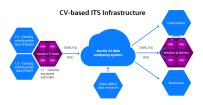We’re living in the era of digital disruption and we need bold digital and technology leadership now more than ever before. Leading this change demands knowledge, imagination, new thinking, an appetite to reinvent and the courage to challenge conventions.
In this series, we're celebrating our team of digital and technology experts and visionaries, spearheading the development and delivery of our technology-forward solutions for smarter working, and better living in Asia Pacific and the Middle East.
For this feature, we caught up with our Senior Intelligent Transport Systems Engineer in the Australia & New Zealand (ANZ) region, Hamid Torfeh Nejad, to understand the efficient role of connected and automated vehicles in the future of ITS infrastructure and the data-driven transformation underway in transportation.
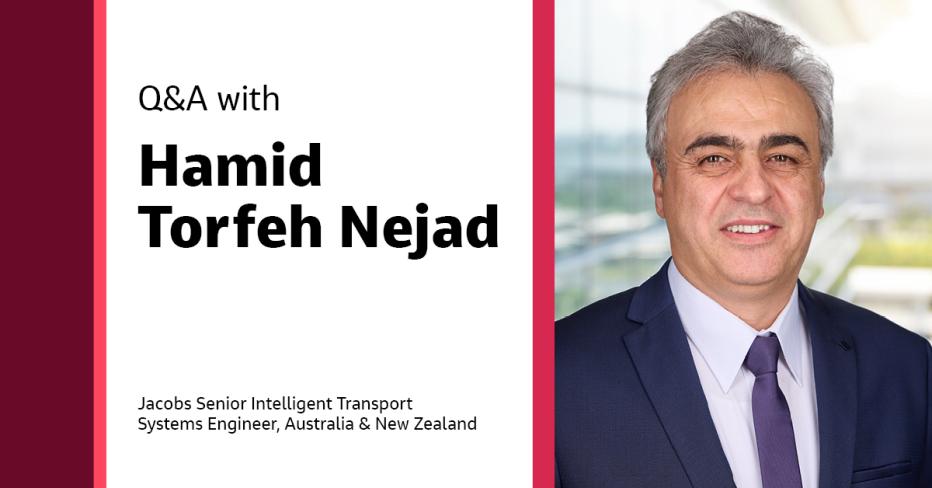
Hi, Hamid. Can you tell us how the work you do is helping deliver Jacobs' strategy?
Jacobs delivers value through cost-effective solutions and services ranging from planning, design, engineering and construction management. These solutions help plan, develop, design, maintain and operate innovative transportation technologies that connect people and communities worldwide.
Connected autonomous vehicles (CAV) technology is shaping the future of ITS platforms. It has the potential to transform how people travel by creating a safe, reliable and efficient transportation system.
Aligning with Jacobs' strategy of boldly moving forward, my work helps plan and design for the opportunities that these new technologies will bring by implementing CAV technology and CV-based ITS platform using innovative methodologies and solutions.
Take us through your career spanning over 20 years and your current role at Jacobs.
I started working in ITS when I joined Iran Road Maintenance & Transportation Organization (RMTO) in May 2000. During my career at RMTO, I played a vital role in many ITS plans. I spearheaded the defining of the country’s first intercity road ITS projects. Led or participated in many key ITS projects and published the results in the ITS World Congresses.
When I came to Australia in Aug. 2017, I presented one year of research on the macroscopic fundamental diagram (MFD) as my Ph.D. sabbatical at the University of Sydney, using Aimsun traffic simulation software and Python programming.
My early experience as an ITS Engineer in Australia was an excellent opportunity to gain familiarity with local experience, Australian workplace structure, procedures, business culture, recognition of local ITS technical companies and talent to build and extend my professional network. I was a team member in the smart motorway design covering electrical and fiber optic communication network infrastructure for ITS devices. We proposed, for the first time in Australia, to use separated extra low voltage (SELV) (48V DC) instead of the low voltage (LV) (230V AC) electrical supply for variable message signs and variable speed limit signs to improve safety and cost reduction. This innovative design was presented at the Australian Institute of Traffic Planning and Management’s National Traffic & Transport Conference held in Brisbane on Sep 2021 (you can read more here: The safety and cost benefits of ELV for ITS field equipment).
In October 2021, I joined Jacobs to demonstrate my capabilities in ITS detail design, strategic planning, leadership and my enthusiasm for providing innovative ideas targeting future ITS infrastructure. I remember the day I was interviewed for my role at Jacobs and how excited I was to describe the potential capability to make Jacobs a CAVs pioneer in Australia.
What made you pursue a career in telecommunications and intelligent transport systems?
My Ph.D. is in electronics engineering, and my bachelor’s and master’s degrees are in telecommunication engineering. When I realized the critical role of telecommunication networks and electrical devices in smart road transportation, I utilized my knowledge to provide innovative and creative ideas in ITS and smart transportation.
As is evident from its name, the foundation of CVs are the telecommunication protocols, devices and systems that provide vehicle-to-everything (V2X) communications. A connected car is intelligent and can communicate bidirectionally with nearby vehicles, connected infrastructure, and the surroundings under all possible conditions. This connectivity is extendable to support different features and systems, such as adaptive routing, real-time navigation, and traffic forecast, to transform the roads into safer and more efficient ones.
How do data solutions enable data-driven transformation in transportation as the world navigates digital transformation?
Data analytics can provide enormous value in the intelligent transportation system by providing governments, businesses, organizations, and individual users with the real-time data they need to create safer and more efficient transportation systems. Data gathering is the most accessible piece of the end-user information production chain loop. The crucial section is data analysis and data-driven transformation.
Public and private transport authorities, agencies and individual drivers increasingly collect significant amounts of near or real-time transit data. The range, scope and volume of data collection and data-driven transformation are expanding daily.
On the one hand, the current big-transit-raw-data collection capability and, on the other hand, the daily increasing analyzed-transit-data demand demonstrates the vital role of transit-data analytic solutions to provide more reliable and secure real-time data and information to the end road user.
More robust transportation data solutions present a massive opportunity to integrate components of existing transport systems better, leading to lower congestion levels, reduced tailpipe emissions, less time spent in transit and optimized transit options to end-user needs and plans. This can regulate cities to match mobility patterns, resulting in cleaner, safer, better-designed communities and more economically flourishing, smarter cities.
“We are transitioning from a traditional ITS platform to a CV-based ITS platform, a high-tech and cost-effective solution to reduce the installation and maintenance cost of fiber communication networks and ITS devices.”
What are some of the critical enabling technologies driving the adoption of intelligent transportation systems?
ITS is one of the foremost global exploration domains and a significant development element for future transportation systems. The objective of ITS is to improve road safety and increase transportation efficiency.
New electronic devices and technologies are currently being used to improve in-vehicle ITS capabilities. Advanced driver assistance system (ADAS) is one of the professional technologies to provide a continuous picture environment surrounding the vehicle and the vehicle engine status. Car manufacturers use this technology to receive the current car's status via their private cloud and provide some special services to the drivers.
CAVs are rapidly developing technologies that seek to transform the global transportation system. Soon, by 2030, around 95% of new vehicles sold globally will be connected, up from approximately 50% today. As connected vehicles and intelligent mobility infrastructure expand, along with the seamless data flow, drivers will benefit from improved safety and efficiency in the transportation network, from intersections to arterial and highways.
As transportation moves towards the environment of connected and autonomous vehicles, communication and data transfer technologies become more important. The new generation 5G can perform ultra-reliable low-latency communications, 20 Gbps peak data rate, 1 ms radio network latency, 10 Mbps/m2 area throughput and 1 million connected devices per square kilometer. C-V2X (cellular-vehicle-to-everything) will become an integral part of the 5G cellular network providing higher capacity, coverage, and performance. C-V2X can provide high-quality service support, expanded coverage and a high data rate with lower latency for moving vehicles.
How do you see connected vehicle systems and enabling technologies accelerating the future of smart vehicles?
The potential benefits of connected vehicle applications are tremendous. Imagine, for instance, the applications that alert you of a car in your blind spot, notify the icy roads ahead, help you find open parking spaces or locate available last-minute ride-share partners. Or think about the application providing speed recommendations to help eliminate unnecessary stops and help vehicles reach optimal fuel efficiency. The connected car technology will not be limited to conventional cars. Automated vehicles will communicate their position, allowing them to drive side by side and merge at high speeds safely. The self-driving cars will also use this technology to communicate with the road infrastructure and cloud system.
CAV mobility applications will help drivers navigate the roads more efficiently and help system operators improve the operation of the nation’s transportation system, reducing congestion, travel delay and overall mobility. Most importantly, cities can deploy these systems today to dramatically improve the effectiveness of their entire traffic management system while reducing the cost and complexity of their infrastructure and preparing for the next generation of connected vehicles.
Agencies are also expected to benefit from using CAVs acting as probes in the network, providing improved intelligence about roadwork traffic management and traffic conditions. This probe data will give agencies a better understanding of demands and network performance, enabling them to develop enhanced traffic control algorithms that support better coordinated and organized vehicle mobility in the network. For a deeper understanding of this, you can read my paper: Incident Detection in Freeway Based on Autocorrelation Factor of GPS Probe Data, published in the International Journal of Intelligent Transportation Systems Research.
Given your varied experience in concept and detailed design development, implementation, project leadership and management of complex ITS and telecommunication projects, can you share a few examples that highlight the transformation underway in transport and mobility?
Transport is already transforming. The Future Vehicles 2030 report (Austroads, 2021) forecasts technology penetration into the vehicle fleet. The report indicates that more than 50% of new cars in Australia are connected cars, which will be more than 80% by 2030. The report identifies two categories of vehicle connectivity: C1 and C2. C1 is the cooperative intelligent transport systems (C-ITS) category, and C2 is the car manufacturer’s cloud. The report shows that within two years, until 2024, around 100% of the new sales cars will be connected to the private car manufacturers’ clouds rapidly.
We are transitioning from a traditional ITS platform to a CV-based ITS platform. The current ITS platform is a fiber optic cable-based communication network connecting the field ITS devices to the traffic management center (TMC) for traffic monitoring and management. This costly system requires installing and maintaining the traffic sensors, communication network and ITS devices such as variable message signs (VMS) and variable speed limit signs (VSLS). The ITS devices notify drivers of traffic conditions and safety issues in this current platform. On the contrary, the CV-based ITS platform will collect traffic data from connected vehicles. Each connected vehicle can be fitted with several sensors providing the vehicle's current state and behavior as vehicle probe data. Traffic flow, speed and density, the fundamental data to analyze traffic situations, will be acquired by vehicle probe data. CV-based ITS platform is a cost-effective solution to reduce the installation and maintenance cost of fiber communication networks and ITS devices. The drivers will receive notifications directly via in-vehicle devices and smartphones.
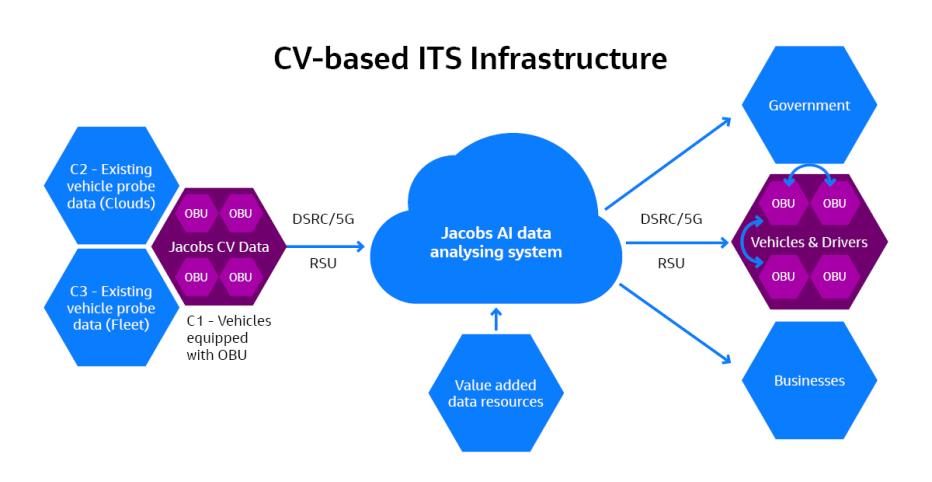
Download full PDF below
Tell us about a memorable project you’ve been involved in and why it’s special to you.
My current project is an excellent experience concerning ITS design due to the challenges and lessons I've learned. I am the ITS communication and electrical package lead in this project and recently submitted the design plan. I can't wait for its implementation and witness the results.
On the other hand, I remember the C-ITS pilot project while working in the middle east in 2015. I was a part of the technical team to define the roadmap and the associated concept design. This project developed and tested V2V and V2I communication systems based on the DSRC, IEEE 802.11p communication protocol. 20 roadside units (RSU) were installed along a 600-kilometer (372-mile) roadway and 300 vehicles were equipped with the produced on-board unit (OBU). Some scenarios implemented successfully were the sudden braking warning, emergency vehicle passing warning, collision warning notification and upside road weather information. This project was significant because the experience gained in an actual C-ITS case study is invaluable for my current and future CAV project delivery.
What are you most passionate about and what’s the favorite part of your role?
I have always loved my work. ITS engineering combines high-tech knowledge, practical technology utilization, non-repeatable challenges and fast-changing trends. I learn something new daily to improve my capabilities and think about tomorrow's smart transportation needs, making me innovate in my career – the favorite part of my role that I enjoy.
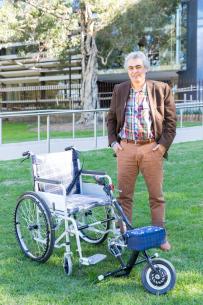
People would be surprised to know…
I have invented a new device and patented it in Australia. This invention is an electrical device to transform a manual wheelchair into a motorized wheelchair quickly and easily. I designed the electrical device, produced the prototype, registered the intellectual property, and achieved the required patent in Australia (in 2018,) which was done within my EasyWheel start-up in the Incubate at the University of Sydney during my Ph.D. research study. This electrical wheel can be attached and detached from a manual wheelchair easily and can improve the lives of people who need a low-cost electrical wheelchair. You can watch a video of the device's functionality here.
What do you enjoy most about being part of #OurJacobs?
#OurJacobs is unique because of our culture, business conduct and the solutions and services we offer that make the world more connected and sustainable. It allows me to work with our phenomenal team members worldwide, implement innovative ideas and drive remarkable project outcomes.
About the inteviewee
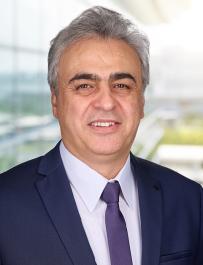
Hamid Torfeh Nejad has been working in the ITS industry for over 23 years, in a career that has taken him from Iran to Australia. He specializes in smart-managed motorway technology deployment and the connected and automated vehicle industry. He has led design teams for deploying these technologies and acting in technical roles for our clients. Hamid is a Ph.D., CPEng, RPEQ, NER and a member of the Engineers Australia ITEE College Committee (Sydney Branch.)
You might be interested in...
Join #OurJacobs team
What drives you drives us as we work to build a better world – together. At Jacobs, every day is an opportunity to make the world better, more connected, more sustainable. We’re always looking for dynamic and engaged people to join our team. Bring your passion, your ingenuity and your vision.
















































